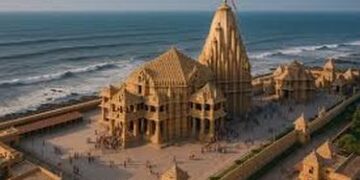By: M Ahmad
Galileo, full name Galileo di Vincenzo Bonaiuti de’ Galilei, born on 15 February 1564, was an Italian Scientist and has been called the “father” of observational Astronomy, Physics and modern science. He played a key role in the history of scienceand is a central figure of the Scientific Revolution of the seventeenth century. His work in physics , astronomy and the methodology of science, still evoke debate after 458 years. His role in promoting the Copernican theory and his travails and trials with the Roman Church are stories that still require re-telling.
As a boy, Galileo was tutored privately and, for a time, by the monks at Vallombrosa, where he considered a religious vocation and then enrolled for a medical degree at the University of Pisa in 1580. He never completed this degree, but instead studied mathematics, notably with Ostilio Ricci, a mathematics teacher attached to the Tuscan court and the Florentine Accademia del Disegno. Galileo studied speed and velocity, gravity and free fall, the principle of relativity, inertia, projectile motion and also worked in applied science and technology, describing the properties of pendulums and “hydrostatic balances”. He invented the thermoscope and various military compasses, and used the telescope for scientific observations of celestial objects. His contributions to observational astronomy include telescopic confirmation of the phases of Venus, observation of the four largest satellites of Jupiter, observation of Saturn’s rings, and analysis of lunar craters and sunspots.
The Thermoscope, One of Galileo Galilei’s most noteworthy inventions made in 1593, an earlier version of the thermometer. The thermoscope was a device built from a small vase filled with water, attached to a thin vertically rising pipe, with a large empty glass ball at the top. Changes in temperature of the upper ball would exert positive or vacuum pressure on the water below, causing it to rise or lower in the thin column. However, the thermoscope depended on both temperature and pressure. A group of academics and technicians known as the Accademia del Cimento of Florence, who included Galileo’s pupil, Torricelli and Torricelli’s pupil Viviani later invented a device known as the Galileo thermometer based on Galileo’s principle on which this thermometer is based.
The Telescope, Galileo made his first telescope in 1609, modeled after telescopes produced in other parts of Europe that could magnify objects three times. He created a telescope later that same year that could magnify objects twenty times. With this telescope, he was able to look at the moon, discover the four satellites of Jupiter, observe a supernova, verify the phases of Venus, and discover sunspots. Galileo had no diagrams to work from, and instead relied on his own system of trial and error to achieve the proper placement of the lenses. In Galileo’s telescope the objective lens was convex and the eye lens was concave (today’s telescopes make use of two convex lenses). Galileo knew that light from an object placed at a distance from a convex lens created an identical image on the opposite side of the lens. Today, over 400 years later, Galileo’s Telescope still survives under the constant care of the Istituto e Museo di Storia della Scienza (renamed the Museo Galileo in 2010) in Italy. The Museum holds exhibitions on Galileo’s telescope and the observations he made with it
The phases of Venus, Galileo used his telescope to show that Venus went through a complete set of phases, just like the Moon. This observation was among the most important in human history, for it provided the first conclusive observational proof that was consistent with the Copernican system but not the Ptolemaic system. In the Copernican system instead, the Sun is immobile at the centre of the universe, while all of the planets, Earth included, rotate around it. The orbits of Venus and Mercury are thus found within the Earth’s orbit. For this reason, they should show the entire range of phases, which is what Galileo managed to observe for the first time. The discovery of the phases of Venus reinforced Galileo’s conviction of the truth of the Copernican system.
The moons orbiting Jupiter: Galileo discovered the planet Jupiter was accompanied by four tiny satellites which moved around it. These are now known as the Galilean moons: Io, Ganymede, Europa and Callisto. Again, this showed that not everything in the heavens revolved around the Earth.
The discovery of Sunspots: Galileo Galilei bears the credit of being one of the first Europeans to observe sunspots. Although, Johannes Kepler had observed one in 1607 by accident, mistaking it for a transit of Mercury, Galileo was the first to observe and intepret them correctly.
The law of falling bodies tells us that every object will fall an equal rate when accounting takes place for minor differences. In order to prove his theory, Galileo himself made a climb to the top of the Leaning Tower of Pisa. This law was in contrast to the theory of Aristotle. This is because the speed of an object’s fall was not proportional to its weight. Many experts had to change their previously held beliefs due to this discovery.
The discovery of the Milky Way: Galileo discovered, the Milky Way, the galaxy and observed that it was not just a band of misty light, but was made up of thousands of individual stars.He stated that the stars appeared as mere blazes of light, essentially unaltered in appearance by the telescope, and contrasted them to planets, which the telescope revealed to be discs. Galileo located many other stars too distant to be visible with the naked eye like the double star Mizar in Ursa Major, which he observed in 1617.
The Principal of the Pendulum: Galileo once noticed that a lamp swinging overhead takes exactly the same time for each swing. This occurrence took place even though the distance of a swing got progressively shorter. This principle of a pendulum made Galileo significantly famous around the world. The principle of the Pendulum states that a pendulum would always take the same amount of time to finish a swing. This is because; there is always the same amount of energy in the pendulum. Moreover, this energy is kinetic energy. There is a transfer of energy from one direction to the other.
There are many more inventions & discoveries named with with Galileo. National Centre for Advanced Studies, INFN created the “Galileo Galilei Medal” award in honour of the founding father of the scientific method and of modern physics. Starting from 2019, the Galileo Galilei Medal is assigned every two years by a special committee appointed by the INFN president with the contribution of the GGI director, the chair of the INFN committee for heoretical physics and the INFN executive board. Galileo wrote a number of book which include, The little balance (La Balancitta), The Starry Messenger, Letter to the Grand Duchess Christina, The Assayer, Dialogue Concerning the Two Chief World Systems ,Two New Sciences, Discourse on Floating Bodies,
It took nearly 200 years after Galileo’s death for the Catholic Church to drop its opposition to heliocentrism. Nearly 70 at the time of his trial, Galileo lived his last nine years under comfortable house arrest, writing a summary of his early motion experiments that became his final great scientific work. He died in Arcetri near Florence, Italy on January 8, 1642 at age 77 after suffering from heart palpitations and a fever.
(The write is Incharge Abhedananda Home-Higher Secondary Institution for Specially-abled Children, Solina, Srinagar, Kashmir email: abhome78@gmail.com)





